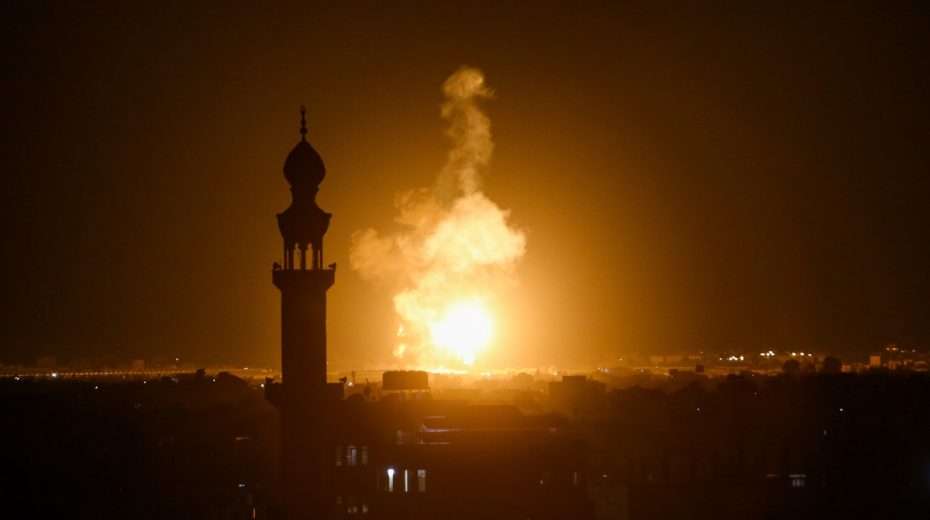Israel resumed attacks on Iran-related targets in Syria late last week and this also appears to be related to certain developments in the war between Russia and Ukraine.
Last Friday evening I, as usual, spent some time on my rooftop which overlooks the Sea of Galilee and a part of the Golan Heights.
Just like almost every Shabbat evening, it was very quiet, until suddenly something changed when in the distance the sound of approaching fighter jets could be heard.
Seconds later, the Shabbat peace was gone, and the sky was filled with the thundering sound of Israeli warplanes.
This time I saw the lights of the IAF fighters and counted four of them.
The first two then seemed to suddenly stand still in the sky above the northern Golan Heights as the other two flew on and turned off their lights a few moments later.
This was the second time this year I had witnessed such a maneuver by IAF pilots.
The ‘stationary’ fighter planes are most likely of the F-35B type, a Lockheed-produced stealth aircraft that is able to hover and also land vertically like a helicopter.
It was immediately clear to me that the Israeli Air Force was once again about to launch strikes in Syria.
Indeed, a few hours later, foreign media reported that the IAF had attacked Iran-related targets near Damascus.
It wasn’t until Monday morning that it became clear what the complete picture was of the maneuvers I observed on the eve of Shabbat.
Not only had the IAF attacked weapons depots near the international airport at Damascus, but also a factory producing unmanned aerial vehicles (UAVs) for Hezbollah and the Quds Force of Iran’s Islamic Revolutionary Guard Corps.
This factory, near the Dimas military airport in southwestern Syria, produces various types of attack drones.
The runway of the Dimas air base, which is home to Iranian-backed Shiite militias, Hezbollah’s special unit 4400, as well as the Quds Force, was also disabled during the IAF attack.
The two IAF aircraft that were standing still in the air were therefore most likely responsible for the attack on Damascus airport, which is relatively close to the Golan Heights, while the other two, which flew on to Rif Dimashq, destroyed the UAV factory.
On Monday, another IAF attack in broad daylight on two targets near Damascus was reported by SANA, the Assad regime’s official news agency, falsely claiming that several IAF missiles had been intercepted.
The sudden resumption of IAF attacks on targets in Syria is likely related to two apparently unrelated events.
First, it was announced last week that Russia has significantly scaled down its military presence in Syria and transferred an S-300 anti-aircraft battery from the Damascus area to the front in Ukraine.
This could partly explain why the IAF again became active in Syria for the first time since September 17.
After all, tensions between Russia and Israel over the IAF attacks against Iran and its allies in Syria had grown before the temporary cessation of these strikes because of Israel’s stance on the war in Ukraine.
See: Russia Tells Israel to Stop Bombing Syria
As I reported earlier, Israel is walking a thin line here because of its stance on Russia’s war against Ukraine.
On the one hand, the government in Jerusalem wants to stay out of that conflict and has officially provided Ukraine only with humanitarian aid, so far.
On the other hand, Israel did join the countries that condemned the Russian aggression against its neighbor and voted for the suspension of Russia from the UN Human Rights Council.
Developments in Ukraine, where Russia uses outright terror tactics and commits war crimes, seem to be making this balancing act more untenable by the day.
The markedly increased overt Russian-Iranian cooperation against Ukraine now seems to have made the government of caretaker Prime Minister Yair Lapid rethink its policies, and this has apparently contributed to a limited Israeli course change.
Iran supplies offensive UAVs to Russia and recently sold 3,000 Shahed 136 kamikaze drones to Vladimir Putin’s army.
This UAV initially did not seem to have much success in the Russian war effort, but that has now changed.
That change can be attributed to the work of IRGC engineers who came to the aid of the Russians in occupied Crimea, from where most drone attacks are launched.
It remains unclear whether the Iranian engineers also operate the Russian UAVs themselves, but the enhanced effect of the Shahed 136 attacks on Ukraine can be attributed to the Iranians.
The attacks are now being carried out in swarms, making it more difficult for the air defenses of the Ukrainian army to take out the Shahed 136 in time.
Lapid now admits that something must be done about the dangerously increased ties between Iran and Russia. He recognizes that this could also have implications for Israel’s security.
The Israeli prime minister said this during an interview with The Jerusalem Post, and further stated that Israel will “proactively help” Ukraine from now on.
By saying this, Lapid seemed to be referring to the news that Israel, together with the army of Ukraine, is going to develop a kind of “Code Red” alert system for the citizens of the Eastern European state.
Such a system has been around for a long time in Israel, where citizens can download an application on their smartphones that indicates when a missile strike is imminent and how much time they have to reach a bomb shelter.
However, there is more to say about Lapid’s comment regarding Israel providing “pro-active help” to Ukraine.
According to The New York Times, which quoted unnamed top Israeli officials, Israel recently provided crucial intelligence to Ukraine about the work of IRGC instructors in the Russian UAV attacks on the country.
This Israeli intelligence enabled Ukraine to launch an attack on a Russian base in Crimea, where IRGC instructors helped the Russians pilot the Shahed 136 UAV. Ten Iranians were killed.
The Ukrainian military also had satellite images of the base that were provided by an Israeli company involved in the security of the Jewish state.
Israel has, furthermore, provided Ukraine with information regarding the Shahed 136 and the technical details of the UAV, which is equipped with a GPS system.
This hitherto secret cooperation between Israel and Ukraine also sheds a different light on Zelensky’s continued criticism of the Jewish state.
Zelensky said on Monday that the Russians are now helping Iran make progress in the Islamic Republic’s nuclear program in exchange for the sale of UAVs like the Shahed 136, which is dangerous for Israel.
See: Zelensky Blames Israel for Russia-Iran Alliance
The Ukrainian president, furthermore, again denounced Israel for refusing to supply the Iron Dome anti-missile shield to Ukraine.
But military experts in Ukraine have previously pointed to the fact that Iron Dome is incapable of taking down Russia’s cruise missiles and does not work against the Shahed 136, so Zelensky’s criticism doesn’t make sense.
Zelensky’s criticisms could therefore be a smokescreen that hides the hidden cooperation between Ukraine and Israel in light of the precarious position of the government in Jerusalem vis-à-vis Russia regarding the covert war against Iran in Syria.














